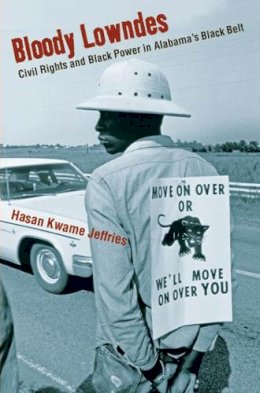
Bloody Lowndes: Civil Rights and Black Power in Alabama’s Black Belt
Hasan Kwame Jeffries
Winner of the 2010 Clinton Jackson Coley Award for the best book on local history from the Alabama Historical Association
A remarkable story of the people of rural Lowndes County, a small Southern town, who in 1966 organized a radical experiment in democratic politics
Early in 1966, African Americans in rural Lowndes County, Alabama, aided by activists from the Student Non-Violent Coordinating Committee (SNCC), established an all-black, independent political party called the Lowndes County Freedom Organization (LCFO). The group, whose ballot symbol was a snarling black panther, was formed in part to protest the barriers to black enfranchisement that had for decades kept every single African American of voting age off the county’s registration books. Even after the passage of the Voting Rights Act, most African Americans in this overwhelmingly black county remained too scared even to try to register. Their fear stemmed from the county’s long, bloody history of whites retaliating against blacks who strove to exert the freedom granted to them after the Civil War.
Amid this environment of intimidation and disempowerment, African Americans in Lowndes County viewed the LCFO as the best vehicle for concrete change. Their radical experiment in democratic politics inspired black people throughout the country, from SNCC organizer Stokely Carmichael who used the Lowndes County program as the blueprint for Black Power, to California-based activists Bobby Seale and Huey P. Newton, who adopted the LCFO panther as the namesake for their new, grassroots organization: the Black Panther Party for Self Defense. This party and its adopted symbol went on to become the national organization of black militancy in the 1960s and 1970s, yet long-obscured is the crucial role that Lowndes County“historically a bastion of white supremacy”played in spurring black activists nationwide to fight for civil and human rights in new and more radical ways.
Drawing on an impressive array of sources ranging from government documents to personal interviews with Lowndes County residents and SNCC activists, Hasan Kwame Jeffries tells, for the first time, the remarkable full story of the Lowndes County freedom struggle and its contribution to the larger civil rights movement. Bridging the gaping hole in the literature between civil rights organizing and Black Power politics, Bloody Lowndes offers a new paradigm for understanding the civil rights movement.
Product Details
About Hasan Kwame Jeffries
Reviews for Bloody Lowndes: Civil Rights and Black Power in Alabama’s Black Belt
Journal of American History
"Bloody Lowndes is an important book. The authors careful analysis of the 1966 election is both readable and quite useful to understanding the importance of the moment."
EverythingAlabama.com
"Jeffries examines the topic more thoroughly and in greater depth than any previous study, pressing the narrative back to Reconstruction but focusing most of his narrative and analysis on the mid-1960s and 1970s. The research is wide-ranging and in great depth, both in archival and oral history sources. . .this book is a needed and important addition to the historiography of the Civil Rights Movement."
CHOICE
"Hasan Kwame Jeffries Bloody Lowndesprovides a nuanced portrait of the marriage between federal policy initiatives and local activism in the battle to dismantle Jim Crow, focusing on the months from March 1965 through November 1966 when SNCC workers, led by Stokely Carmichael, were active in Lowndes County, Alabama."
American Studies
"Jeffries' book sets a new standard for the political history of African Americans in the rural South by refocusing on the mechanics of power taken, used, lost, and retaken between blacks and whites, rather than the larger fabric of social and cultural politics. Given the stark and still unrelieved inequalities of the black belt, thisis a salutary stance."
Van Gosse
Journal of Southern History
"An extensively researched, well-written, and extremely important book that will make a tremendous contribution to the historiography of the Civil Rights and Black Power movements."
Emilye Crosby,author of A Little Taste of Freedom: The Black Freedom Struggle in Claiborne County, Mississippi "Excellent scholarship, important history, and an invaluable contribution to understanding current and future conversations on race and politics in a dynamically changing political environment."
Charles V. Hamilton,co-author of Black Power: The Politics of Liberation "Jeffries has written the book historians of the black freedom movement have been waiting for. His beautifully written account rescues Lowndes County from its role as merely a backdrop to & Black Power, to being one of the key battlegrounds for democracy in the United States. Here are local people whose local struggles have contributed mightily to the kind of politics we desperately need in the Obama agethe politics of ‘freedom democracy,’ a politics born in Reconstruction, rooted in social justice and human rights, and honed in the Alabama cotton belt."
Robin D. G. Kelley,author of Freedom Dreams: The Black Radical Imagination "Jeffries is at the top of a very short list of ‘young lions’ paving the way for a new interpretation of the history of the Civil Rights-Black Power movement. His work on the legendary Lowndes County Freedom Organization is outstanding in terms of the breadth and carefulness of research, depth and clarity of conceptualization, organization and presentation of material, and the originality and the wealth of the results."
Komozi Woodard,author of A Nation Within a Nation: Amiri Baraka (LeRoi Jones) and Black Power Politics "Jeffriess Bloody Lowndes is an important contribution to the literature of the African American freedom struggle. Jeffries reveals the deep historical roots of black struggles against racial and economic oppression in the Black Belt. He makes clear that the civil rights reforms of the 1960s were insufficient responses to the & freedom politics that spawned the Lowndes County Freedom Organizationthe first Black Panther Party."
Clayborne Carson,author of In Struggle: SNCC and the Black Awakening of the 1960s
